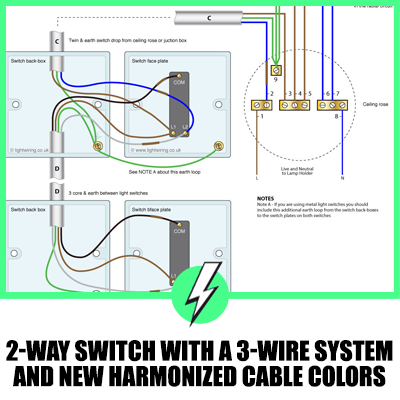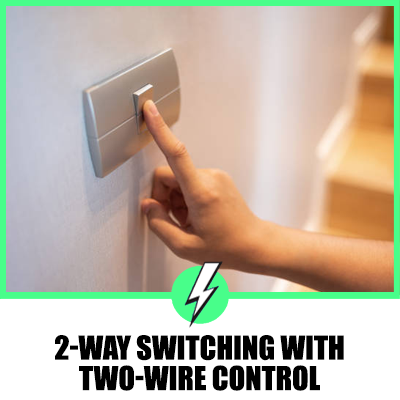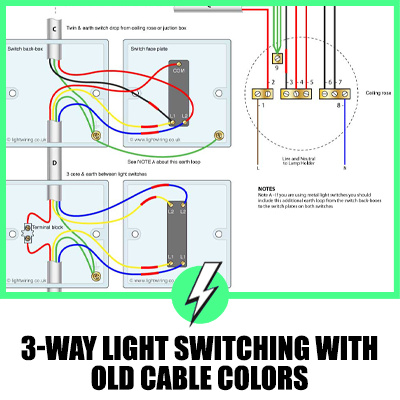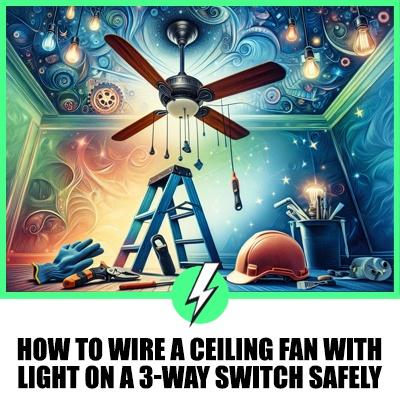2-Way Switch with a 3-Wire System and New Harmonized Cable Colors
Curious about how a 2-way switch with a 3-wire system works, especially with the new harmonized cable colors in the UK?
It’s a common setup that offers the convenience of controlling a light from two different locations, but with the added twist of modern, standardized wiring colors.
This article will delve into the essentials of this configuration, highlighting the practical benefits and the safety considerations it brings to electrical installations.
We’ll be going over:
- What exactly is a 2-way switch with a 3-wire system?
- How do the new harmonized cable colors enhance safety and compliance?
- What are the advantages of using this system in your home or building?
Get ready to illuminate your understanding of this electrical setup.
Let’s dive in!

Contents
Overview of the 2-Way Switch with a 3-Wire System
The 2-way switch with a 3-wire system involves the use of two switches to control a single light or fixture from different locations.
It requires three-core cable with specific harmonized colors for each core, in accordance with UK wiring regulations.
This configuration allows for easy control and flexibility, as users can turn the light on or off from either switch position.
2 way switch (3 wire system, new harmonised cable colours)
A two-way switch setup with a three-wire system, now using the updated harmonised cable colors, allows for the control of a single lamp from multiple locations through two or more switches.
This configuration ensures that the light can be operated from any of the switches, making it a common solution for areas like staircases, where a switch can be placed at both the top and bottom, or in extended hallways that have a switch at each end.
This particular setup employs two single gang two-way switches connected by a three-wire control, illustrated with the new harmonised cable colors.
While it’s feasible to obtain a similar functionality with a two-wire control system, which might reduce cable usage, this method is not advised.
The three-wire system is the preferred choice for its effectiveness and safety.
Here we a have a schematic (Fig 1) which makes it easy to visualise how this circuit works.
In this state the lamp is off, changing the position of either switch will switch the live to the lamp turning it on.
If you now change the position of the other switch the circuit is broken once again.
Fig 1: Two way switching schematic wiring diagram (3 wire control)
The schematic is nice and simple to visualise the principal of how a two way switch works but is little help when it coms to actually wiring this up in real life!!
Fig 2 below shows how we achieve this configuration. Just like any loop-in loop-out radial circuit, the switch cable from the ceiling rose contains two wires, a permanent live and a switched live.
This is cable C below, one wire connects to L1 and the other to L2 on the top switch.
Cable D (Fig 2) is a three core and earth, this is the ‘3 wire control’ that links the two light switches together.
COM on the first switch connects to COM on the second switch, L1 on the first switch connects to L1 on the second, and L2 on the first switch connects to L2 on the second.
All earth wires should connect to the earth terminal in the switch back-box and if you are using metal switches there MUST be a loop from this earth terminal to the one on the switch plate (see note A on Fig 2)
Fig 2: Two way light switching (3 wire system, new harmonised cable colours)
NOTE: The Grey wire in cable ‘D’ is a switched live and the Blue wire in cable ‘C’ and Black wire in cable ‘D’ are permanent lives and thus should be marked with brown sheathing at each end as shown.
Key Components and Connections
- Two Switches: Two 2-way switches are used in this configuration. One switch is typically located at the bottom of a stairwell or at the entrance of a room, while the other switch is installed at the top of the stairs or at a secondary location within the room.
- Three-Core Cable: A three-core cable, consisting of three individual wires with harmonized colors, is used to establish connections between the switches and the light or fixture.
- Live: Brown
- Switched Live: Black
- Neutral: Blue
- Lighting Point: The lighting point refers to the location of the light or fixture being controlled. It is connected to the switches using the three-core cable.
- Earth: The earth wire, usually green and yellow striped, provides a safety connection and is connected to earth terminals or metal fixtures as per wiring regulations.
Switching Operation
The 2-way switch with a 3-wire system allows users to control the light or fixture from either switch position.
When one switch is in the “on” position, the other switch can turn the light off or on.
The switches work in tandem, with the switching live wire being alternated between the switches to control the flow of electricity to the light or fixture.
Advantages of the 2-Way Switch with a 3-Wire System
- Convenient Lighting Control: This wiring configuration offers convenient control of lights or fixtures from different locations, providing flexibility and ease of use.
- Enhanced Safety: The inclusion of an earth wire ensures proper grounding and safety, reducing the risk of electrical shocks or malfunctions.
- Harmonized Cable Colors: The use of harmonized cable colors in the three-core cable simplifies installation and promotes conformity with current wiring regulations.
Conclusion
The 2-way switch with a 3-wire system and new harmonized cable colors is a popular electrical wiring setup in the UK.
By understanding its key components, connections, and switching operation, individuals can install or modify lighting circuits to provide convenient control from multiple locations.
This configuration’s convenience, safety features, and adherence to harmonized cable colors reflect the UK’s commitment to electrical safety and standardized wiring practices.





